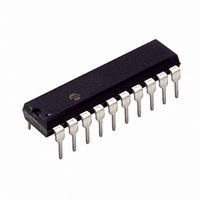PIC18LF13K22-I/P Microchip Technology, PIC18LF13K22-I/P Datasheet - Page 105

PIC18LF13K22-I/P
Manufacturer Part Number
PIC18LF13K22-I/P
Description
IC PIC MCU FLASH 256KX8 20-PDIP
Manufacturer
Microchip Technology
Series
PIC® XLP™ 18Fr
Datasheets
1.PIC18LF13K22-ISS.pdf
(388 pages)
2.PIC18LF13K22-ISS.pdf
(12 pages)
3.PIC18LF13K22-ISS.pdf
(36 pages)
4.PIC18LF14K22-IP.pdf
(382 pages)
Specifications of PIC18LF13K22-I/P
Program Memory Type
FLASH
Program Memory Size
8KB (4K x 16)
Package / Case
20-DIP (0.300", 7.62mm)
Core Processor
PIC
Core Size
8-Bit
Speed
64MHz
Connectivity
I²C, LIN, SPI, UART/USART
Peripherals
Brown-out Detect/Reset, POR, PWM, WDT
Number Of I /o
17
Eeprom Size
256 x 8
Ram Size
256 x 8
Voltage - Supply (vcc/vdd)
1.8 V ~ 3.6 V
Data Converters
A/D 12x10b
Oscillator Type
Internal
Operating Temperature
-40°C ~ 85°C
Processor Series
PIC18LF
Core
PIC
Data Bus Width
8 bit
Data Ram Size
256 B
Interface Type
I2C, MSSP, SPI, USART
Maximum Clock Frequency
32 KHz
Number Of Programmable I/os
18
Number Of Timers
4
Operating Supply Voltage
1.8 V to 3.6 V
Maximum Operating Temperature
+ 125 C
Mounting Style
Through Hole
3rd Party Development Tools
52715-96, 52716-328, 52717-734, 52712-325, EWPIC18
Development Tools By Supplier
PG164130, DV164035, DV244005, DV164005
Minimum Operating Temperature
- 40 C
On-chip Adc
10 bit, 12 Channel
Lead Free Status / RoHS Status
Lead free / RoHS Compliant
Lead Free Status / RoHS Status
Lead free / RoHS Compliant, Lead free / RoHS Compliant
- PIC18LF13K22-ISS PDF datasheet
- PIC18LF13K22-ISS PDF datasheet #2
- PIC18LF13K22-ISS PDF datasheet #3
- PIC18LF14K22-IP PDF datasheet #4
- Current page: 105 of 388
- Download datasheet (4Mb)
TABLE 10-1:
10.5
The TMR1 register pair (TMR1H:TMR1L) increments
from 0000h to FFFFh and rolls over to 0000h. The
Timer1 interrupt, if enabled, is generated on overflow,
which is latched in the TMR1IF interrupt flag bit of the
PIR1 register. This interrupt can be enabled or disabled
by setting or clearing the TMR1IE Interrupt Enable bit
of the PIE1 register.
10.6
If either of the CCP modules is configured to use Timer1
and generate a Special Event Trigger in Compare mode
(CCP1M<3:0> or CCP2M<3:0> = 1011), this signal will
reset Timer1. The trigger from CCP2 will also start an
A/D conversion if the A/D module is enabled (see
Section 13.3.4 “Special Event Trigger” for more
information).
The module must be configured as either a timer or a
synchronous counter to take advantage of this feature.
When used this way, the CCPRH:CCPRL register pair
effectively becomes a period register for Timer1.
If Timer1 is running in Asynchronous Counter mode,
this Reset operation may not work.
In the event that a write to Timer1 coincides with a
special Event Trigger, the write operation will take
precedence.
2010 Microchip Technology Inc.
Osc Type
Note:
Note 1: Microchip suggests these values only as a
LP
2: Higher capacitance increases the stability
3: Since each resonator/crystal has its own
4: Capacitor values are for design guidance
Timer1 Interrupt
Resetting Timer1 Using the CCP
Special Event Trigger
The Special Event Triggers from the CCP2
module will not set the TMR1IF interrupt
flag bit of the PIR1 register.
starting point in validating the oscillator
circuit.
of the oscillator but also increases the
start-up time.
characteristics, the user should consult
the resonator/crystal manufacturer for
appropriate values of external
components.
only.
32 kHz
Freq.
CAPACITOR SELECTION FOR
THE TIMER OSCILLATOR
27 pF
C1
(1)
27 pF
C2
(1)
Preliminary
PIC18F1XK22/LF1XK22
10.7
Adding an external LP oscillator to Timer1 (such as the
one described in Section 10.4 “Timer1 Oscillator”
above) gives users the option to include RTC function-
ality to their applications. This is accomplished with an
inexpensive watch crystal to provide an accurate time
base and several lines of application code to calculate
the time. When operating in Sleep mode and using a
battery or supercapacitor as a power source, it can
completely eliminate the need for a separate RTC
device and battery backup.
The application code routine, RTCisr, shown in
Example 10-1, demonstrates a simple method to
increment a counter at one-second intervals using an
Interrupt Service Routine. Incrementing the TMR1
register pair to overflow triggers the interrupt and calls
the routine, which increments the seconds counter by
one; additional counters for minutes and hours are
incremented on overflows of the less significant
counters.
Since the register pair is 16 bits wide, a 32.768 kHz
clock source will take 2 seconds to count up to over-
flow. To force the overflow at the required one-second
intervals, it is necessary to preload it; the simplest
method is to set the MSb of TMR1H with a BSF instruc-
tion. Note that the TMR1L register is never preloaded
or altered; doing so may introduce cumulative error
over many cycles.
For this method to be accurate, Timer1 must operate in
Asynchronous mode and the Timer1 overflow interrupt
must be enabled (PIE1<0> = 1), as shown in the
routine, RTCinit. The Timer1 oscillator must also be
enabled and running at all times.
Using Timer1 as a Real-Time Clock
DS41365D-page 105
Related parts for PIC18LF13K22-I/P
Image
Part Number
Description
Manufacturer
Datasheet
Request
R

Part Number:
Description:
Manufacturer:
Microchip Technology Inc.
Datasheet:

Part Number:
Description:
Manufacturer:
Microchip Technology Inc.
Datasheet:

Part Number:
Description:
Manufacturer:
Microchip Technology Inc.
Datasheet:

Part Number:
Description:
Manufacturer:
Microchip Technology Inc.
Datasheet:

Part Number:
Description:
Manufacturer:
Microchip Technology Inc.
Datasheet:

Part Number:
Description:
Manufacturer:
Microchip Technology Inc.
Datasheet:

Part Number:
Description:
Manufacturer:
Microchip Technology Inc.
Datasheet:

Part Number:
Description:
Manufacturer:
Microchip Technology Inc.
Datasheet:










